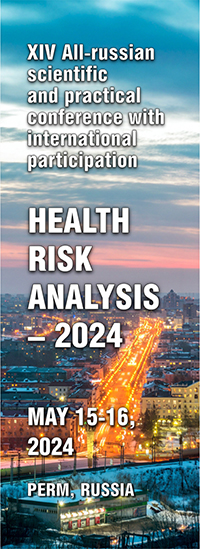Optimizing the system of diagnostics, treatment and prevention provided to children with environmentally induced transitory immune dysfunction
Introduction. The performed studies resulted in the development of a three-level system of specialized treatment and prevention provided to individuals living in environmentally unfavorable areas. The system includes primary care (the 1st level), medical regional centers for specialized treatment and prevention (the 2nd level), and regional and federal consultation and diagnostic centers (the 3rd level). The most significant and efficacious level is primary care aimed at preventing environmental exposure and pathological conditions at pre-existing disease stage.
Purpose. To assess the efficacy of primary care in children with environmentally induced transitory immune dysfunction.
Material. We examined 121 children (aged 4-7 years) with blood levels of chemical technogenic substances elevated by 10-15%. The patients suffered from environmentally induced transitory immune disorders manifesting in frequent (more than 4-5 times per year) acute respiratory infections (ARI) (infection index – 0.3-1.0), changes in immune indicators (lymphocytosis – up to 57.9±1.1%, p=0.03, monocytopenia – 3.21±0.27%, p=0.05, low absolute phagocyte count (1.59±0.16x103/L, p=0.001), increased total IgE (up to 167.8±17.79 IU/ml, p=0.001), increased antioxidant activity (AOA) (up to 68.9±2.2x103/L, p=0.001). A control group was comprised of 77 children who were treated according to national healthcare and economic guidelines.
Methods. We used elimination (increased fluid intake, measured physical activity, walking outdoors, enterosorbents and/or plant-based cholagogues over a 10-day period) and recovery (plant-based immunomodulators and antioxidants (polyvitamins containing trace elements with apparent antioxidant properties) technologies. The medication administration course was 21 day twice a year.
Results. The study group demonstrated a 1.5 fold decrease in AOA levels, a 1.9 reduction in total IgE levels, a 2.3-fold increase in absolute phagocyte count, lower ARI frequency (from 95.0% to 30.8%, p=0.001) compared to the control group (from 92.0% to 74.0%, p=0.19).
Conclusions. Thus, the optimized primary care program has proven to be efficacious in preventing environmental diseases in children with environmentally induced transitory immune dysfunction.
Source: Evidence-based child health: a Cochrane review journal (Vienna, 23-26 june 2011).




